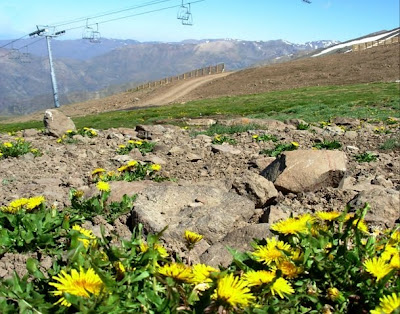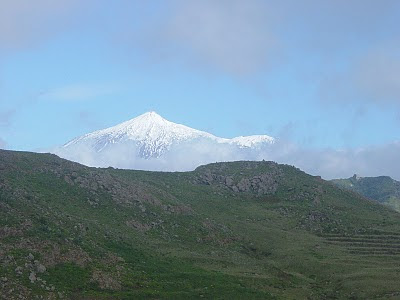 Un equipo internacional de investigadores ha estudiado la distribución de las especies vegetales en ambientes montañosos. El trabajo confirma que las comunidades de plantas montañosas no son tan resistentes frente a las invasiones de plantas exóticas. Los científicos también alertan de que éstas pueden ser más agresivas en un escenario de calentamiento global.
Un equipo internacional de investigadores ha estudiado la distribución de las especies vegetales en ambientes montañosos. El trabajo confirma que las comunidades de plantas montañosas no son tan resistentes frente a las invasiones de plantas exóticas. Los científicos también alertan de que éstas pueden ser más agresivas en un escenario de calentamiento global.En 2005, científicos de diferentes centros científicos de España, Alemania, Suiza, Australia, EE UU y Chile crearon la Red de Investigación de Invasiones de Montaña (MIREN) para estudiar la distribución de especies exóticas en ambientes de alta montaña y diseñar experimentos que confirmen la capacidad invasora de ciertas especies en ambientes de alta montaña.
“Estas comunidades de plantas de ambientes alpinos eran consideradas hasta ahora poco vulnerables a este tipo de perturbación ambiental”, señala a SINC José Ramón Arévalo, uno de los autores del estudio, e investigador en el Departamento de Ecología de la Universidad de La Laguna. Sin embargo, sus experimentos ponen de manifiesto “la errónea visión que se tiene sobre esta supuesta protección y resistencia de ambientes montañosos contra las especies invasoras”, añade el experto.
El estudio, publicado recientemente en Frontiers in Ecology and The Environment y que se enmarca dentro MIREN, ha permitido identificar los factores que favorecen la vulnerabilidad que tienen las plantas de estas áreas a las invasiones de otras especies.
Entre otros factores, los científicos destacan la facilidad de llegada de propágulos (modalidad de reproducción asexual en vegetales por la que se obtienen nuevas plantas) debido a la actividad humana, así como el aumento de perturbaciones, la poca resistencia biológica de las comunidades de plantas invadidas, el aumento del transporte entre zonas de alta montaña alejadas, y el estimado según modelos de cambio climático global, “que facilitaría el establecimiento de plantas invasoras también para la reproducción”, manifiesta el ecólogo.
 An international research team has studied the distribution of plant species in mountainous environments. The study shows that mountain plant communities are not particularly resistant to invasion by exotic species. The scientists also warn that these may become more aggressive as global warming gets a grip.
An international research team has studied the distribution of plant species in mountainous environments. The study shows that mountain plant communities are not particularly resistant to invasion by exotic species. The scientists also warn that these may become more aggressive as global warming gets a grip.In 2005, scientists from various science centres in Spain, Germany, Switzerland, Australia, the United States and Chile created the Mountain Invasion Research Unit (MIREN) in order to study the distribution of exotic species in high mountain species and to design experiments to confirm the invasive capacity of certain species in high mountain environments.
"These plant communities in Alpine environments have until now not been thought particularly vulnerable to this kind of environmental disturbance", José Ramón Arévalo, one of the authors of the study and a researcher at the Department of Ecology of the University of La Laguna, tells SINC. However, the experiments show clearly "that the beliefs about this supposed protection and mountain species' resistance to invasive species is erroneous", he adds.
The study, published recently in Frontiers in Ecology and The Environment, and which is part of the work done by MIREN, has made it possible to identify the factors that make plants in these areas more vulnerable to invasion by other species.
Among other factors, the scientists stress the ease of movement of propagules (plants which can reproduce asexually in order to produce new plants) as a result of human activity and the increase in environmental disturbance, the low levels of biological resistance of invaded plant communities, the increase in transport between high mountain areas that are far apart from each other, and the risks according to climate change models, "which will make it easier for invasive plants to establish themselves and reproduce", the ecologist explains.
Tomado de/Taken from Plataforma SINC español/english
Resumen /Summary
Ain't no mountain high enough: plant invasions reaching new elevations
Frontiers in Ecology and The Environment 7(9): 479-486 (2009)
Aníbal Pauchard, Christoph Kueffer, Hansjörg Dietz, Curtis C Daehler, Jake Alexander, Peter J Edwards, José Ramón Arévalo, Lohengrin A Cavieres, Antoine Guisan, Sylvia Haider, Gabi Jakobs, Keith McDougall, Constance I Millar, Bridgett J Naylor, Catherine G Parks, Lisa J Rew and Tim Seipel
Most studies of invasive species have been in highly modified, lowland environments, with comparatively little attention directed to less disturbed, high-elevation environments. However, increasing evidence indicates that plant invasions do occur in these environments, which often have high conservation value and provide important ecosystem services. Over a thousand non-native species have become established in natural areas at high elevations worldwide, and although many of these are not invasive, some may pose a considerable threat to native mountain ecosystems. Here, we discuss four main drivers that shape plant invasions into high-elevation habitats: (1) the (pre-)adaptation of non-native species to abiotic conditions, (2) natural and anthropogenic disturbances, (3) biotic resistance of the established communities, and (4) propagule pressure. We propose a comprehensive research agenda for tackling the problem of plant invasions into mountain ecosystems, including documentation of mountain invasion patterns at multiple scales, experimental studies, and an assessment of the impacts of non-native species in these systems. The threat posed to high-elevation biodiversity by invasive plant species is likely to increase because of globalization and climate change. However, the higher mountains harbor ecosystems where invasion by non-native species has scarcely begun, and where science and management have the opportunity to respond in time.
1 comentario:
hola a todos y a Yasmin Sierbengad y también a Yazmin Juares
Publicar un comentario